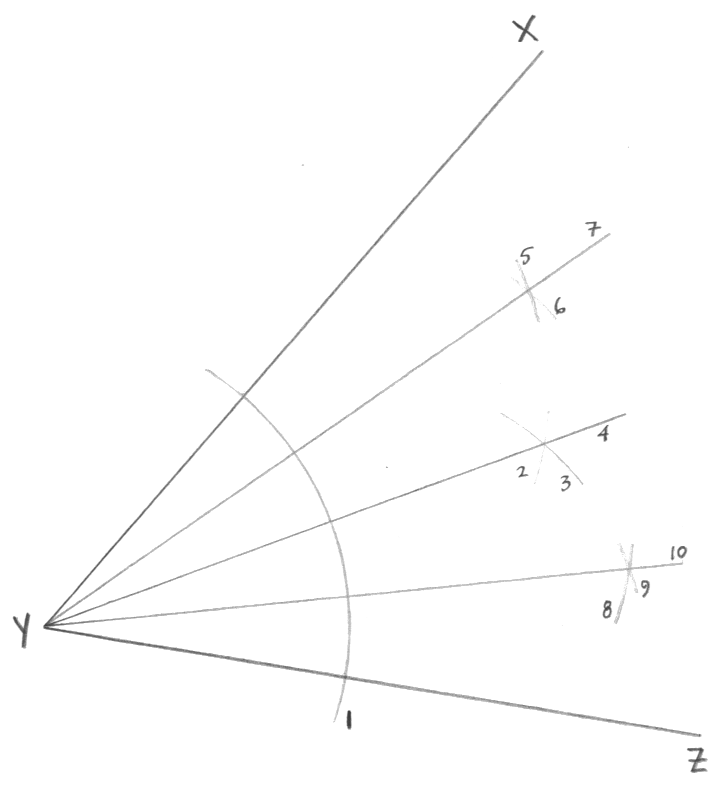 LaripS.com, © Bradley Lehman, 2005-22, all rights reserved. All musical/historical analysis here on the LaripS.com web site is the personal opinion of the author, as a researcher of historical temperaments and a performer of Bach's music.
Tetrasecting an angle......er, splitting a major third into its four component tempered fifths...As is apparent from this diagram, with compass and straightedge it is easy to split a known angle (here the arbitrary angle XYZ) into four equal pieces. We just bisect it first, and then bisect the results as well. It's like making a paper airplane, or doing other origami.The step sequence is numbered. We do not even need to know the size of the original angle XYZ in any particular system of measurement, whether it is degrees or radians or something else. The geometrical construction makes it moot to measure it. Better yet, this method requires almost zero time or effort. If it is just a piece of paper, we needn't even bother with the compass and straightedge but merely start folding it...! Now, let's do the same thing on a musical keyboard, where a goal is to set up four equally-sized fifths C-G-D-A-E within some known size of major third C-E (or alternately, regular fifths F-C-G-D-A within a known F-A).The handy operation here, akin to the use of the compass in the above diagram to make arcs, is as follows:
Example: splitting a known major third of middle C up to its neighboring E.
ExtensionThen, having a core of four consecutive regular fifths, this same technique can be extended as far as it needs to go, to set up whatever fifths the temperament requires to be this same regular size. Put the left hand onto the five-finger position having whatever two of the three notes are already known and tuned. Use that plus the triplets-vs-duplets rule to tune whichever note is missing. The fourth played by fingers 1-4 must beat 3/2 as fast as the fifth played by fingers 1-5.
SummaryFrom a single beat rate, i.e. the size of the generating major third, we can construct an entire meantone temperament (or a subset) simply by using the triplets-vs-duplets rule, with the left hand playing fingers 5, 4, and 1. (Reverse the whole thing and use fingers 1, 2, 5 of the right hand if you tune left-handed....) It is not necessary to memorize or refer to a whole table of beat rates for all the intervening fifths/fourths. The correct relationships are generated automatically, and in only a few minutes, using this geometric construction.Note 1: this has nothing to do with the so-called "equal beating methods" of Jorgensen, which are shortcuts instead of creating accurate intervals. The technique described here generates equally-sized, "theoretically correct", intervals. Note 2: we can set up any arbitrary size of "meantone" temperament knowing only a single number: the beat rate of the first major third. We can even set up comma divisions in the cracks, or to taste, by starting from whatever C-E sounds good to us (zero or higher). The technique here generates equally-sized fifths, starting from whatever our initial boundary is. See also the page of practical instructions to set up Bach's and other temperaments, using this same technique, and the general discussion of meantone features.
Need to start the Bach temperament from a C fork?I gave it from an A fork on the "practical instructions" page. What should you do with a C fork instead? No problem.Middle C up to E must beat 4.5 times per second. If that's hard to hear, copy middle C down to the next one first, as an octave. Then play the major 10th from that new C up to middle E. It also must beat 4.5; we're matching the same overtone here (the sound of E up inside the C's tone). The added space makes it easier to hear here. Having got the C-E correctly as the boundary, construct the regular C-G-D-A-E fifths as described above. Then put in the F below middle C, again using that triple-vs-duple technique, comparing the F-C fifth against the (already tuned) G-C fourth next to it. The G-C fourth must beat 3/2 as fast as the F-C; adjust the F until it does so. F is our missing note under the left hand's 5, 4, 1 pattern; therefore it's the note we are allowed to move. Now we have our core F-C-G-D-A-E, the same as if we'd started from an A fork. Pop back over to the practical instructions page and proceed with "Pure fifths E-B-F#-C#", etc. etc.
Of related interest: construction/trisection/tetrasectionApril 17, 2006: I am adding a link here to Paul Vjecsner's "Presumed Impossibilities", containing a compass-and-straightedge construction that trisects angles. (That is a classically "impossible" problem.) I arrived at Vjecsner's page after seeing his advertisement in the March 2006 issue of Scientific American magazine.
 |
v Introduction v Articles v FAQ v Practice > Theory - Measurements - Comparisons - Other "Bach" - [Extra]ordinary - Regular/Mean - Enharmonics - Cube puzzle * Geometric 5ths - TU & Schismas - Fa Ti Modulation v History v Etc v Recordings |



